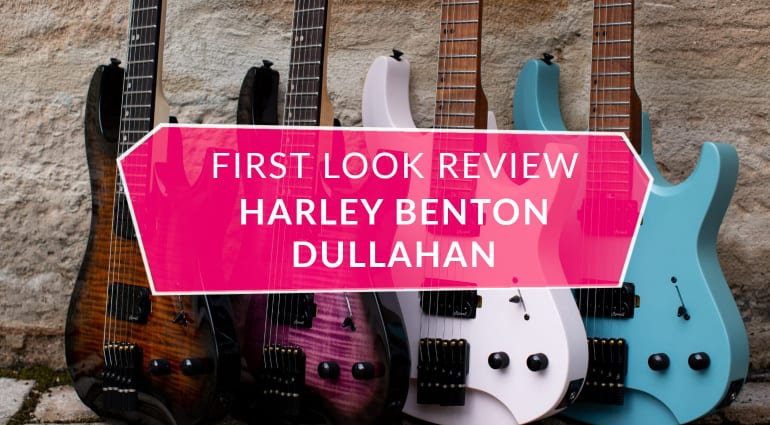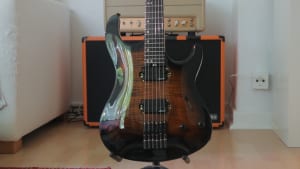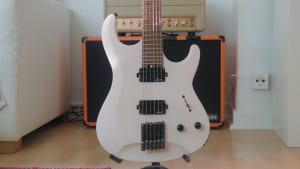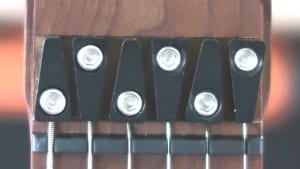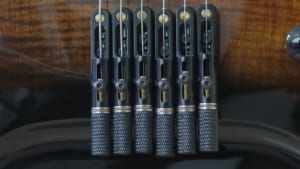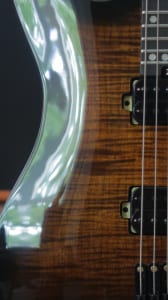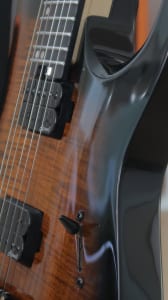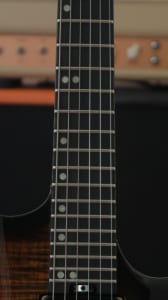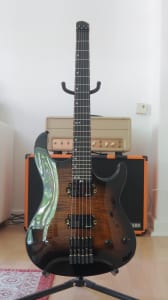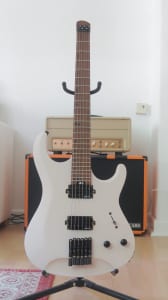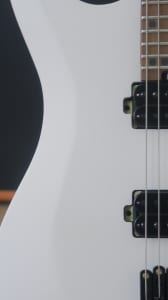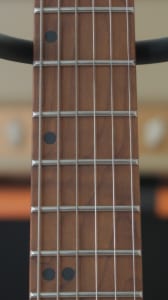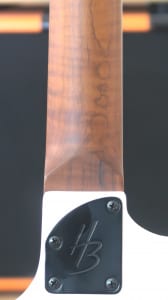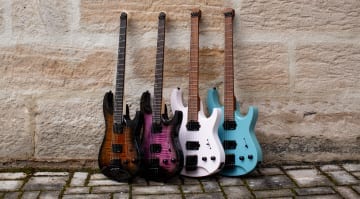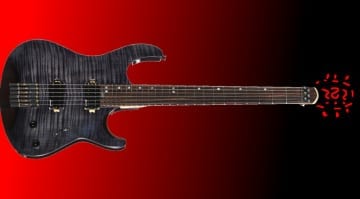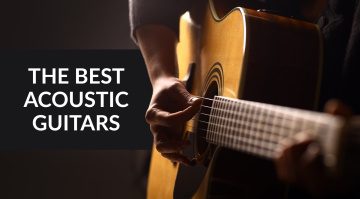First Look Review: Harley Benton Dullahan FT-24 and AT-24
The nice folk over at Harley Benton asked us if we would like to try two of their guitars out. Of course we said yes! Especially since we really enjoyed the SC-550 they’d sent over. And when we found out they were to be the company’s headless, 24-fret Dullahan models, we were even more excited.
Harley Benton Dullahan
Harley Benton sent us two of its headless guitar models, the Dullahan-FT 24 Roasted and the Dullahan-AT 24. Both guitars were officially launched last year, so the specs are still the same. However, there have been new colours added to the range, and we were able to get a first look at them.
First Impressions
I’ve never played a headless guitar, but I know they’re smaller than regular guitars. But the boxes these guitars came in were much smaller than I’d expected. Open the box, and the guitar comes in a gig bag. Nice! The first guitar I unboxed was the Shell Pink Dullahan FT-24, and man, it looks stunning! The finish is flawless, and the shade is perfect. Much lighter than a Fender Shell Pink, and in a satin finish. And, it has a roasted, flame maple neck! I put it on the stand and just looked at it for a bit.
No way is the other model, whatever finish it was, going to top this. The roasted maple neck, with the Shell Pink and the black hardware simply looks fantastic. But, also, the guitar looked tiny! We’re talking travel guitar territory here. The body is considerably smaller than that of, say, a Strat. I look in the gig-bag pocket for any tools, but don’t find any, just a tag on the guitar.
I unbox the other guitar, take it out of its gig bag, and realised I was wrong about it not being able to top the first one. The Dullahan AT-24 is a beautiful, carved, flame maple top in a glossy Tiger Black Burst. And an ebony fretboard! And, of course, the black hardware. I looked the guitar over and I could not find any blemishes. Fit and finish is impeccable. This one came with a bag of tools and a QR code. And by tools I mean 3 different hex-keys, a little rod, and a funny looking golden screw-driver.
Both guitars look, as the cool kids say, ‘sick’.
- Dullahan AT-24 · Source: Gearnews
- Dullahan FT-24 Roasted · Source: Gearnews
Specs
Hardware and electronics on both instruments are the same. You get a 648 mm (25.5”) scale-length and a 350 mm (13.78”) radius neck, with 24 stainless steel jumbo frets, and a Graph Tech TUSQ XL on the necks of both guitars. Both feature body-mounted Roswell HAF-B-BK (bridge) and Roswell HAF-N-BK AlNiCo-5 (neck) humbuckers, a 5-way switch, and a master volume and tone control. Both necks have a satin finish and feel smooth.
Although construction material for both versions differ, both the choice of woods and the hardware seem top notch for the price of the instruments. And both guitars are ridiculously light.
- ‘Headstock’ · Source: Gearnews
- Bridge · Source: Gearnews
Harley Benton Dullahan AT-24
The Harley Benton Dullahan AT-24 version has a mahogany body and an arched top (the ‘AT’ in the name). The flame maple is just a veneer, but looks awesome. It has a black back with a very deep belly cut. The neck is maple with an ebony fretboard, and the truss rod can be adjusted easily at the base of the neck. As I mentioned earlier, I could not find any issues with the fit and finish. The neck is smooth, with soft edges, no frets sticking out, and they all seem level. However, bending a string across them doesn’t feel very smooth. It’s a bit scratchy. A shame, as the SC-550 we got to review had really nice fretwork.
The guitar has six individual saddles on the bridge, these are mounted to a base plate using the intonation screws. Then, the height can be adjusted using two more screws, one of which locks the main height adjustment screw. It’s a clever little system. And since there isn’t a headstock, you use the barrels behind the saddles to tune. The ‘headstock’ itself is a set of six screws that lock the strings in place.
I’ve always thought of headless guitars to be designed for speed and shred. So naturally, I thought the neck on this model would be fast and slim. It’s not. It isn’t fat, but there’s definitely some chunk to it. It’s still a very comfortable neck to play, just not a thin one. The neck heel is slightly sculpted for better access.
- AT-24 Carved top · Source: Gearnews
- Carved top · Source: Gearnews
- Ebony fretboard · Source: Gearnews
Playability
Playing it for the first time, if you haven’t ever played a headless guitar, might take a little getting used to. I found myself reaching for the tuners on the headstock to tune the guitar. And in the beginning, was worried that every time I tune a string on the bridge, my clumsy fingers might inadvertently tune another string out. It took a little while, but I got used to it in the end.
Once I got used to the guitar, it was a lot of fun to play. Access to the upper frets is easy. The neck feels smooth and, thanks to its light weight, the guitar doesn’t feel cumbersome at all. It’s well-balanced, and comfortable both standing and sitting.
Electronics
You get a 5-way switch for bridge humbucker, neck and bridge single coils, neck and bridge humbuckers, neck humbucker parallel, neck humbucker. That’s enough tonal variations, but the pickups and pots could be improved. The pickups sounded a bit weak and brittle. Not bad, but not my favourite.
The volume pot is also not the best. It sucks out the tone and sounds tinny as you roll it down. But for a headless guitar with these specs for this price, I’m not complaining. And, it seems that a lot of people buy Harley Bentons as a modding platform anyway. Which is really cool, I think. But if you don’t, it doesn’t sound bad. Though I do think the electronics give its affordability away.
- Dullahan AT-24 · Source: Gearnews
- Dullahan FT-24 Roasted · Source: Gearnews
String change and intonation
I was hoping I wouldn’t have to restring the guitar because of all the parts and then, thanks to a wild bend, the ball-end of the high E string went flying out the back. So unless I wanted to review a 5-string guitar, I had no choice but to swap out the strings. I brought out the tools.
The bridge/saddle (hex key – 1) end is relatively simple, the headstock (hex key – 2) bit not so much. Under the locking screw for each string on the headstock is a tiny disc. This sits on top of the string. But it kept wanting to slip under. I decided to lower the action a bit too, just to my liking (hex key – 3 and funny looking screw-driver). The action was easy, but the intonation was a bit fiddly.
Once all this was done, especially the action lowered (considerably, I wanted to check how level the frets were), the guitar played like a dream (minus those scratchy frets).
Harley Benton Dullahan FT-24
The Harley Benton Dullahan FT-24, or flat top version, has an alder body and a roasted maple neck and fretboard. Although flat, the body still has a nice bevel for where your arm would rest. Otherwise, the specs are identical. I set this one the same as the AT-24. Lowered the action a bit and adjusted the intonation slightly.
Since the electronics are identical, I wasn’t expecting a night and day difference. It did sound a tiny bit brighter, which probably comes down to the choice of woods used. The rest of my observations were the same; the electronics could be upgraded, and those frets need a polish.
- Beveled edge on DUllahan FT-24 Roasted · Source: Gearnews
- Roasted maple fretboard · Source: Gearnews
- Back of neck and plate · Source: Gearnews
Verdict
Harley Benton may be a budget brand aimed at beginners, but these guitars are no slouches. The construction is excellent, and they both look gorgeous. You can’t go wrong with either model. Although I would go for the AT-24, simply because of that lovely top. It’s a fantastic 24-fret model that would be welcome in any studio or any stage. And thanks to its diminutive size, portability should not be an issue. And if you just want to play at home, it’s the perfect guitar to have around to play on your sofa, etc.
If you’re in the market for a headless model to add to your already growing collection of guitars, depending on the specs you are fond off, you might or might not like the pickups/electronics on these models. But that is an easy swap. And things like action are always a personal preference after a few years of playing, and easy to adjust.
If, on the other hand, you’re a newbie or a beginner, and looking to get a headless model, I’d first like to congratulate you on your confidence in going the headless route. You can’t go wrong with the Dullahans. The action was maybe slightly higher than 1.5 mm on the 12th fret on both guitars, which is fairly reasonable. Intonation was also ok, just a bit flat. But not so bad that a newcomer to the instrument would lose interest.
Another bonus (I suppose) is, that if you are brand conscious, or if Harley Benton conjures up images of cheap stuff, neither guitar has the brand name on the front. The only way you could tell it’s a Harley Benton is by the logo on the neck plate on the back. Which you can replace if you want!
Do remember though, you won’t be able to use your guitar hangers!
More Information on Harley Benton
You are currently viewing a placeholder content from YouTube. To access the actual content, click the button below. Please note that doing so will share data with third-party providers.
This post contains affiliate links and/or widgets. When you buy a product via our affiliate partner, we receive a small commission that helps support what we do. Don’t worry, you pay the same price. Thanks for your support!


 3,5 / 5,0 |
3,5 / 5,0 | 